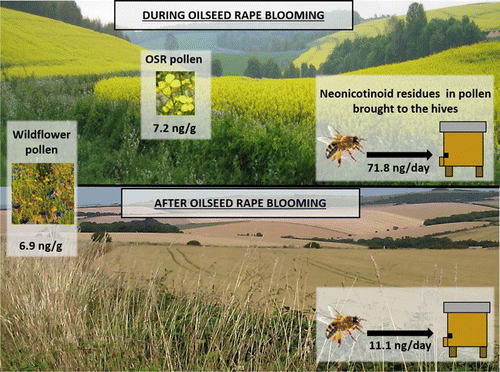Wildflowers on farms—not just crops—can expose bees to neonicotinoids

Since bee colonies started declining at alarming rates over the past few decades, some scientists have identified a group of pesticides called neonicotinoids that are commonly used on crops as a potential contributor. Now one team reports in ACS' journal Environmental Science & Technology that bees could be getting an unexpected dose of neonicotinoids from wildflowers on farms. Their results suggest past studies may have underestimated the bees' exposure to these compounds.
Scientists trying to close in on the causes of bee declines have identified a mix of pressures that could be to blame. Loss of habitats, and contact with parasites and neonicotinoids all have been cited as possible factors. Past research on neonicotinoids has focused mainly on bees' exposure through crops treated with the pesticides. But because several flowering plants grow naturally on farms, and farmers often sow wildflowers near fields to attract pollinators, Cristina Botías and colleagues suspected that they could be a missing piece of the puzzle.
The researchers analyzed pollen samples from plants growing in areas close to arable fields and from beehives on five farms in the U.K. They found that pollen from wildflowers growing in these locations often contains neonicotinoid residues. In addition, 97 percent of neonicotinoids in the pollen that bees brought back to honey bee hives was from wildflowers, which were not directly treated with the pesticides. They say that neonicotinoids are likely leaching through the soil and being taken up by the nearby wildflowers. The team says their results suggest that exposure is likely to be higher and more prolonged than currently recognized.
More information: Cristina Botías et al. Neonicotinoid Residues in Wildflowers, a Potential Route of Chronic Exposure for Bees, Environmental Science & Technology (2015). DOI: 10.1021/acs.est.5b03459
Abstract
In recent years, an intense debate about the environmental risks posed by neonicotinoids, a group of widely used, neurotoxic insecticides, has been joined. When these systemic compounds are applied to seeds, low concentrations are subsequently found in the nectar and pollen of the crop, which are then collected and consumed by bees. Here we demonstrate that the current focus on exposure to pesticides via the crop overlooks an important factor: throughout spring and summer, mixtures of neonicotinoids are also found in the pollen and nectar of wildflowers growing in arable field margins, at concentrations that are sometimes even higher than those found in the crop. Indeed, the large majority (97%) of neonicotinoids brought back in pollen to honey bee hives in arable landscapes was from wildflowers, not crops. Both previous and ongoing field studies have been based on the premise that exposure to neonicotinoids would occur only during the blooming period of flowering crops and that it may be diluted by bees also foraging on untreated wildflowers. Here, we show that exposure is likely to be higher and more prolonged than currently recognized because of widespread contamination of wild plants growing near treated crops.
Journal information: Environmental Science & Technology
Provided by American Chemical Society















